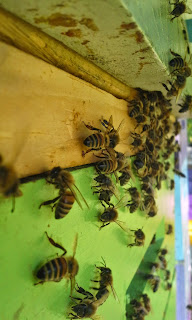 While at my bee supplier's we got to talking as usual about bees. He showed me a picture of a horse's injured foreleg.
While at my bee supplier's we got to talking as usual about bees. He showed me a picture of a horse's injured foreleg.
The owners were struggling to save the horse's badly injured and infected leg. If it couldn't be saved the horse would have to be put down. They tried antibiotics but they weren't working. Thank goodness they heard about the power of honey to cure wounds. They used honey on the wounds and the horse's leg healed and was saved. The picture was of the horse's healed leg.
I'm sure you've heard about the antibacterial and antifungal power of honey.
The ancient Egyptians knew all about honey and now modern medicine is learning to turn back time and use ancient methods when modern ones fail.
I've seen documentaries in hospitals where leeches were used to keep blood flowing through reattached fingers. If not for the leeches work to keep the blood flowing through the reattached limb, the person would lose their finger.
 Now, back to honey. I was watching one of my favourite shows on Animal Planet called Supervet. There was a dog's paw that was badly crushed. The vet had to take pieces of bone from the dog's hip to create new foot bones. It was a really complicated surgery. As often happens after an invasive surgery tht takes a long time to heal the dog's paw eventually became infected. They were using antibiotics and they weren't working very well.
Now, back to honey. I was watching one of my favourite shows on Animal Planet called Supervet. There was a dog's paw that was badly crushed. The vet had to take pieces of bone from the dog's hip to create new foot bones. It was a really complicated surgery. As often happens after an invasive surgery tht takes a long time to heal the dog's paw eventually became infected. They were using antibiotics and they weren't working very well.
The Supervet (who really knows his stuff) used Manuka honey. I watched as he poured the honey into and onto the wounds. And I'm sure you know the outcome. The dogs paw healed up beautifully. The vet is using medical grade Manuka honey for his clients but all honeys have healing powers because of their antibacterial and antifungal properties.
Manuka plant (also called tea tree) is well known to be a powerful healing agent because of the properties of the manuka plant itself which is in the honey.
Manuka honey is often used by hospitals to put on foot ulcer's of diabetic patients. These ulcers are hard to heal and often don't respond to antibiotics. That's when honey steps in to save the day, and the patient's foot.
Manuka/Tea Tree honey is harvested in New Zealand and southeastern Australia. Manuka honey is highly valued and sells at a premium to medical organizations.






